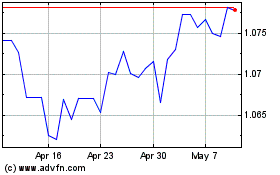Euro Falls As Eurozone Inflation Slows
September 30 2014 - 6:42AM
RTTF2
The euro slipped against its major opponents in European deals
on Tuesday, as Eurozone inflation slowed in September from last
month, a setback to the European Central Bank which has been
struggling to revive growth in the bloc.
Eurozone inflation slowed marginally in September as expected,
flash data from Eurostat showed.
Inflation came in at 0.3 percent, down from 0.4 percent in
August. It continues to stay below the European Central Bank's
target of 'below but close to 2 percent'.
Core inflation that excludes energy, food, alcohol and tobacco,
eased to 0.7 percent in September, while it was forecast to remain
unchanged at 0.9 percent.
The unemployment rate in the eurozone remained stable as
expected in August, a separate report showed.
The jobless rate came in at 11.5 percent in August, the same
rate as in July. This matched economists' expectations.
The ECB is not expected to take any fresh steps at the
conclusion of its policy meeting on Thursday. The ECB President
Mario is expected to reveal more details of its asset-backed
securities and covered bond purchase plans when the bank's
governing council meets in Naples.
The euro lost 0.7 percent to 1.2601 against the greenback, a
level not seen since September 3, 2012. At yesterday's close, the
pair was quoted at 1.2684. Continuation of bearish move may lead
the euro to a support around the 1.25 region.
The euro fell to 0.7773 against the pound, its weakest since
July 2012. This is 0.5 percent lower from Monday's close of 0.7809.
The next possible support for the euro-pound pair lies around the
0.77 mark.
The U.K. economy grew more than estimated in the second quarter,
data from the Office for National Statistics showed.
Gross domestic product grew 0.9 percent sequentially, up from
the prior estimate of 0.8 percent. The annual growth was confirmed
at 3.2 percent.
The euro that closed yesterday's deals at 138.87 against the yen
declined to near a 3-week low of 138.17. If the euro extends its
slide, 137.00 is seen as its next possible support level.
The unemployment rate in Japan came in at a seasonally adjusted
3.5 percent in August, data from the Ministry of Internal Affairs
and Communications showed.
That was well below forecasts for 3.8 percent, which would have
been unchanged from the July reading.
The euro edged down to a session's low of 1.2061 against the
Swiss franc. Further downtrend may see the euro challenging support
around the 1.20 level.
A leading indicator for Switzerland decreased less than expected
in August, a report from economic institute KOF showed.
The KOF leading indicator slid to 99.1 on August from the
revised 99.6 in July.
The euro hit a 5-day low of 1.4428 against the aussie and an
8-day low of 1.4055 against the loonie, off early highs of 1.4586
and 1.4165, respectively. Next key support level for the euro is
seen around 1.435 against the aussie and 1.40 against the
loonie.
The single currency reversed from an early high of 1.6375
against the kiwi with pair trading at 1.6233. The euro is poised to
test support around the 1.615 region.
Looking ahead, U.S. S&P/Case - Shiller home price index for
July and consumer confidence in September are due in the New York
session.
Euro vs US Dollar (FX:EURUSD)
Forex Chart
From Apr 2024 to May 2024

Euro vs US Dollar (FX:EURUSD)
Forex Chart
From May 2023 to May 2024
